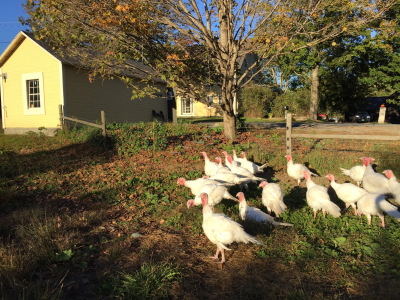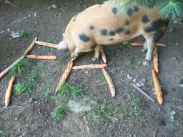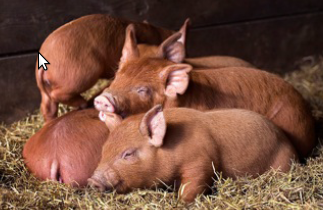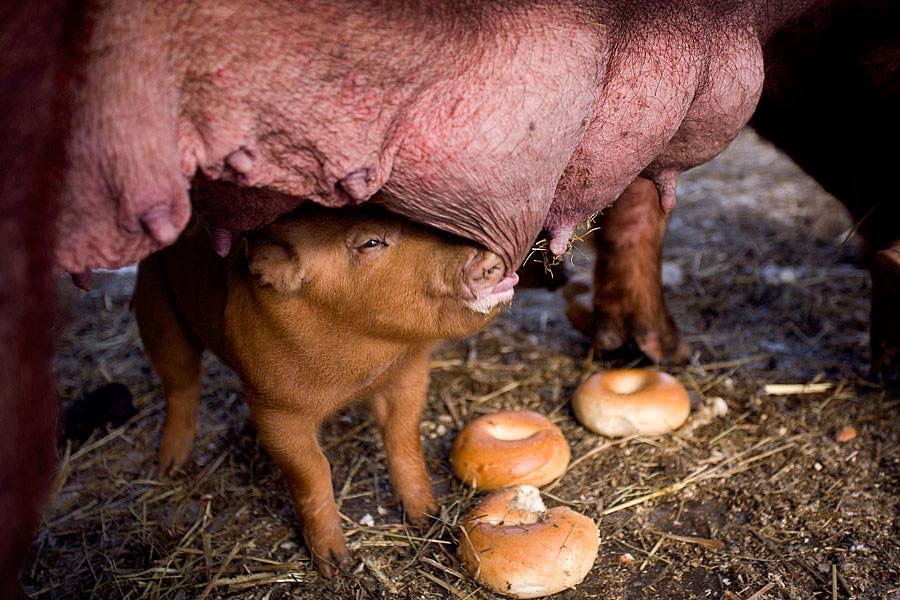|
Technically spring arrives this week, although you wouldn't know it by the amount of snow of the ground after the big storm last week. But, piglets are being born, our hay supply is getting low, and Gwen, the goddess of sheep shearing just came - so springtime weather can't be too far off.
I just got back a load of sheepskins from Pennsylvania and it is a gorgeous batch! These make a unique and useful baby shower present, a soft addition to an office chair, or a really nice dog bed. They are washable, last forever , and are easy to ship. Below are photos of a couple beauties, and I can email more photos if interested. April is the start of the CSA spring quarter which runs through June. Sign up for a monthly selection of our 100 % grass fed beef, heritage breed pork, pastured chicken, and lamb (optional). The April share will have the option of a smoked ham or lamb roast for the Easter meal. Visit Hogwash Farm at Flavors of the Valley on April 9 from 11am-3pm at Hartford High School gym. The local food tasting expo is always delicious and always fun. Hope to see you there!
1 Comment
With the last of our haying done for the season, we are finally starting to catch up with the long list of neglected things around the farm that need doing – like bush hogging, stacking firewood, and weeding the garden. We welcomed four new Belties to the farm this month. We picked up 3 cows and a heifer from the Smith family in Thetford a few weeks ago. The three ladies are due to calve any day now, so maybe there will be some little belties by Thursday! The turkeys are growing fast now! They’ve moved to a new pasture and are loving this warm weather. The birds will be processed at the end of October and will be frozen for until Thanksgiving. Reserve your turkey soon as we always sell out. There should also be a few fall lambs and a litter of piglets born this week. We’ll have fresh chickens is the share this month along with grass fed beef short ribs just back from the butcher. Try this yummy ragu recipes from Minimally Invasive – it’s even better as a left over!
See you are Thursday! Hard to believe that May has come and gone so quickly! The month was full of moving critters out to pasture, outdoor farmers’ markets, gardening, the arrival of chicks, and lots of asparagus. It’s been a great year for asparagus. Fresh picked bunches are for sale in the farm stand. Leslie expertly held down the fort two weekends while we travelled for family obligations. She even found time to spruce up the farmstand and paint some much need signage. The pastures and crops are off and running with all the warm July-like weather we had. Soon it will be time to hay…
June share will include bacon, burger, and beef short ribs. This easy recipe from the Food Network’s Giada De Laurentiis makes heavenly short ribs. And since it is grill season – add a little excitement this month and cook your bacon on the grill – delicious! Will the snow ever end? The view from Snowmass, Colorado. it was 60 degrees and SUNNY during my vacation. Thanks to Dave for staying at the farm so I could get away! Lots of spring lambs! Will there be grass soon? How cute are we? Are you sure she’s coming home soon?
The biggest culprit when preparing grass-fed meat is overcooking due to its lower fat content than conventional meat. Many unsuccessful grass-fed meat experiences are due to improper cooking methods. This beef is best for rare to medium cooking. If you like well-done meat, then cook your grass fed beef at very low temperatures in a sauce or liquid to add moisture; using a crock pot is a good option. Reduce the temperature
Reduce the temperature of standard (grain fed) beef recipes by 50 degrees. The cooking time for grass-fed beef will be about 30% – 50% less than standard (grain fed) beef, even at the lower temperature. Use a digital meat thermometer (120-145 degrees for rare-medium) and don’t overcook your meat. The meat will continue to cook when removed from heat. Since the meat cooks quickly, it can progress from perfectly cooked to overcooked in less than a minute. Lamb can be cooked at slightly higher temperatures and for slightly longer than beef. Thaw completely before cooking For best results, thaw your meat in the refrigerator or if it is important to thaw more quickly, place the vacuum sealed package in warm water. Thawing completely will eliminate the “weeping” of watery red liquid onto your plate.completely will eliminate the “weeping” of watery red liquid onto your plate. Use olive oil, tenderizer, or marinate for enhanced flavor and moisture Grass-fed meat is low in fat. Coating the meat with olive oil will add to the flavor and moisture and also prevent sticking. Using a meat tenderizer (a 16-bladed puncturing tool) helps the meat accept marinade more generously. If you do not own a meat tenderizer, marinate your beef, especially the lean cuts like the NY Strip Steak and Sirloin Steak. Stove top cooking steaks, while a bit risky, is preferable to grilling because you can control the heat more accurately. However, our steaks are thick, which helps protect them from overcooking and also allows you to grill them with greater success. The heat on a grill is correct when you can hold your hand next to the meat on the grill for 3 seconds. Baste to add moisture throughout the grilling process. Use a digital meat thermometer to closely monitor your meat while cooking. Try this: Sear … then roast One of our favorite steak preparation methods, also used by many chefs, is to sear a steak or lamb chop quickly over a high heat on each side (two-four minutes per side) to seal in its natural juices and then place in a pre-heated 400 degree oven to finish the cooking process (about 4-6 minutes). Preheat the oven or pan or skillet you plan to cook in starting at a low temperature and slowly raising the temperature. When roasting, sear the beef or lamb first to lock in the juices and then place in a pre-heated oven. Use moisture from sauces to add to the tenderness when cooking your roast. Cut across the grain When you cut the meat, cut across the grain as this will improve texture because you are cutting the fibers in the meat into shorter segments. Let it rest before eating Let the beef or lamb sit in a warm place for about ten minutes before enjoying. Our first lambs of the season arrived Sunday, March 1st! The rest of the month will be filled with new arrivals, midnight barn checks, and lots of fun watching the youngins grow and bounce. This is my favorite time of year – you can feel spring is right around the corner with the sun is climbing the horizon, the chickens are starting to lay, seeds are being planted, and the Union Village field is teeming with incredibly cute jet black and neon white lambs springing and chasing as they test out their new legs.
At night the ewes are loafing in the barn, peacefully eating hay, keeping an eagle eye on their progeny as they form a gang of jesters looking for trouble. I can spend endless evening hours in the barn amid the contented flock chuckling at the goofiness of the lambs and soaking in the calm of the scene- there is nothing like it. Be sure to take a peak at the new arrivals when you come to pick up your March share this Thursday. This month’s share features our extra-thick loin pork chops. The double cut means a longer cooking time, but it has the benefit of being harder to over-cook and dry out. I usually just throw them on the grill with a little salt and pepper and they are divine. If you have more time to prepare dinner you can try the delicious stuffed Pork Chop Saltimbocca from Epicurious which is oh, so good. Serve with some wonderfully sweet, locally grown spinach and you have a meal fit for a king! Introducing the Hogwash Farm CSA Blog! After five years, I thought is was time to retire the monthly newsletter – which was fun to put together, but was not very useful as a searchable collection of information and recipes. Switching to the more user-friendly CSA blog will making finding specific recipes or cooking techniques for our meats much easier. Farm happenings, photos, and recipes will still be included. I will start transferring some of the more useful articles from past newsletters into the blog, starting with the Grass Fed Primer (below) from 2011. January was busy around the farm with animals coming going, and moving. I was happy to wish a bon voyage to 30+ piglets that were born here in November that went to a farm in Concord, MA. Piglets are such fun to have around, but they grow fast – it was past time for this bunch to leave mom and move on! Lots of people have been asking how the animals manage with the windy, cold, and snow this winter. Below are some photos Dave took around the farm in January. The only animals put out by the winter weather are the laying hens. They are not fans of snow and are counting the day until spring – which according to Punxsutawney Phil will be at least 6 more weeks… The February share will include a maple sausage made with a new recipe from a different processor. I would love to hear everyone’s opinion – good or bad – about the new version. Also, in the share will be a pork shoulder. Pulled pork is one of the easiest and most delicious meals! Perfect for a winter weekend with the slow cooker doing all the work and served with your favorite barbecue sauce. Try this classic recipe from Chow Hound or go on the wild side with Korean Pulled Pork from Bobby Flay. Stay warm!! Nancy Below is an excerpt from “The Grassfed Primer” which is a publication produced by Animal Welfare Approved. You can find a PDF of the entire piece here.
The Grass Fed Primer Grass fed beef is not only lower in overall fat and in saturated fat, but it has the added advantage of providing more omega-3 fats. Studies from around the world have shown that meat from grass fed animals has two to four times more omega-3 fatty acids than meat from grain fed animals. Omega-3s are often called ”good fats“ because they play a vital role in every cell and organ system in the human body. It might surprise you to know that, of all the fats, they are also the most heart- friendly. Indeed, people who have ample amounts of omega-3s in their diet are less likely to have high blood pressure or an irregular heartbeat. These crucial healthy fats are most plentiful in flaxseeds and fish, and are also found in walnuts, soybeans and in meat from animals that have grazed on omega-3 rich grass. Interestingly, scientists have also found that even if cattle start their lives on grass they immediately begin losing the health benefits, such as the omega-3s stored in their tissues, when they are taken off grass and shipped to a feedlot for fattening on grain. As a consequence, the meat from feedlot animals typically contains 50–85 percent less omega-3s than meat from grass fed livestock. Conjugated linoleic acid (CLA) is another “good” fat worth examining. When ruminants are raised on fresh pasture alone, their meat and milk contains three to five times more CLA than similar products from animals fed grain-based diets. Scientists now believe that CLA may be one of our most potent defenses against cancer. In laboratory animals, a very small percentage of CLA — a mere 0.1 percent of total calories — greatly reduced tumor growth. Other studies have shown that a study group of hamsters fed a diet of CLA had lower amounts of LDL (low density lipoprotein) in the blood, as well as a reduced risk of developing early aortic athero-sclerosis. Another study from Iran found that adults with rheumatoid arthritis showed a significant decrease in blood pressure after CLA additions to their diet. Research has also shown that grass fed meat is higher in vitamin E than meat from grain fed animals and — surprisingly — higher than that of grain fed animals that were given high doses of synthetic vitamin E supplements. In humans, we know that natural vitamin E in the diet is linked with a lower risk of heart disease and cancer. Greetings!
This month’s Hogwash newsletter comes to you from Dave, in order to help cut down Nancy’s keyboard time. Nancy devotes pretty much all daylight and quite a bit of the rest to Hogwash- whether in the field, barn, or office. Changes this year have placed even more demand on her, but with the help of very capable Leslie, the work was shared. I helped when possible, but my day job as a mechanic (at Cedar Circle Farm) took me out of the daily loop here. If you experienced our Thanksgiving turkey pickup, you might have an idea of how much effort is needed behind the scenes. Winter is mildly calmer but brings a different set of issues. Water must be carried to bowls because hoses do not work. Grazing is not an option, so hay is fed, and barnyards are crowded. Cold weather demands more bedding for the animals. Snow (when it happens) buries electric fence wires, requiring close maintenance. If the precip is liquid, flooding and mud are problems (note: I love summer…). So, the newsletter isn’t filled with news, just a note to say “all is well” but it’s time to take a breath; and also to thank everyone for their continued support. Dave (& Nancy!) They say that the only constant is change, and Hogwash has some change in its future. While we have enjoyed our time on Kerwin Hill, we are excited about our upcoming move to a different farm in Norwich. We will be relocating to Goodrich Four Corners Road and Union Village Road (land formerly farmed by Suzanne Lupien).
There are wonderful fields for the cattle and sheep to graze and some neglected fields for the pigs to renovate. Since our flocks and herds need to fit the new landscape we will be increasing our flock of Jacob sheep and reducing the numbers of our breeding pigs. Our goal is to have more time to focus on good grazing practices while tuning up general farm operations. We will still endeavor to produce a high quality product that is sustainably raised. The transition should be smooth since we are only moving a few miles away. We will start moving animals to the new spot in the coming weeks with the goal to be moved in by October. We are certainly going to miss our Union Village neighborhood, but we are looking forward to being part of the Root District community. The Root District Creamery became a local hub for the community during Suzanne’s tenure and we are hoping the same will be true when Hogwash has settled in. We value and need the support of the community to keep the farm active and vibrant. The farm has been part of Norwich history for some time. The original barn dates back to 1786 –making the homestead one of the oldest in Norwich. We will do our best to respect the history while gearing it up to a working farm again. The September pick up will be the last CSA pick up at Kerwin Hill. The fall quarter will start with the new farm location – I’ll make sure to highlight the venue change in next months newsletter. We will be having our Pig Roast September 11th on Kerwin Hill so everyone can come and enjoy the farm and the animals before the big move. We hope to see everyone there! Nancy & Dave We are just about to start the season when Hogwash Farm is awash with piglets. We have 30 sows and two boars that produce around 400 piglets per year. Pigs can reproduce all year and our sows have two litters per year. The gestation for a pig is 114 days (or three months, three weeks and three days as the old timers used to say). Litters average anywhere from 6-16 piglets and the piglets are 2-3 lbs and are completely mobile as soon as theyʼre born. Our pigs live out side year-round and so piglets are born in all kinds of weather and usually do pretty well as long as Mom is around to protect them and keep them warm. Body heat is essential this time of the year and youʼll often see a bunch of piglets in a pile trying to conserve heat.
Sows usually farrow(birth) without any assistance from us. The piglets come out in a thin sac that usually scuffs off during birth. Labor can last several hours and it averages about 30 minutes per piglet. Piglets can come out head first or back legs first depending on where they are in the uterus. A sow usually has two placentas which can come out at any time during the birthing process and the sows often eat when they are all done. As soon as the piglet enters the world it tries to make itʼs way to the sows belly to nurse. A piglet will nurse exclusively for three weeks and will then start eating and drinking anything the sow consumes. Piglets are weaned anywhere from 6-8 weeks and are usually 25-45 lbs. Our Spring piglets sell out early every year and go to various farms and individuals that will raise them for six months (when they weigh 250-300 lbs) and they go for slaughter. We keep about 100 of our piglets each year to raise out for meat for the CSA and other sales. |
Archives
March 2017
Categories
All
Follow us on Facebook and Instagram!
|
Meat raised with integrity in the Root District of Norwich, Vermont
































 RSS Feed
RSS Feed